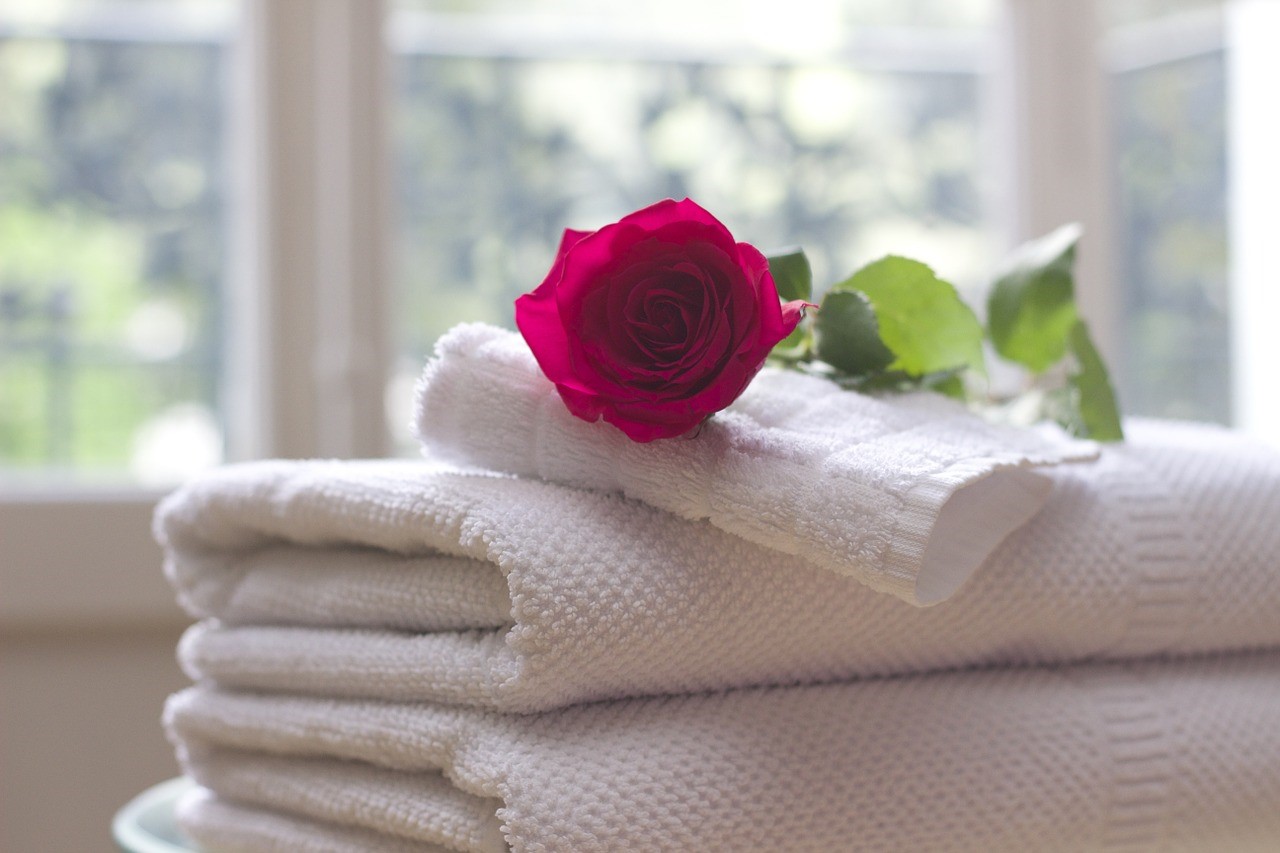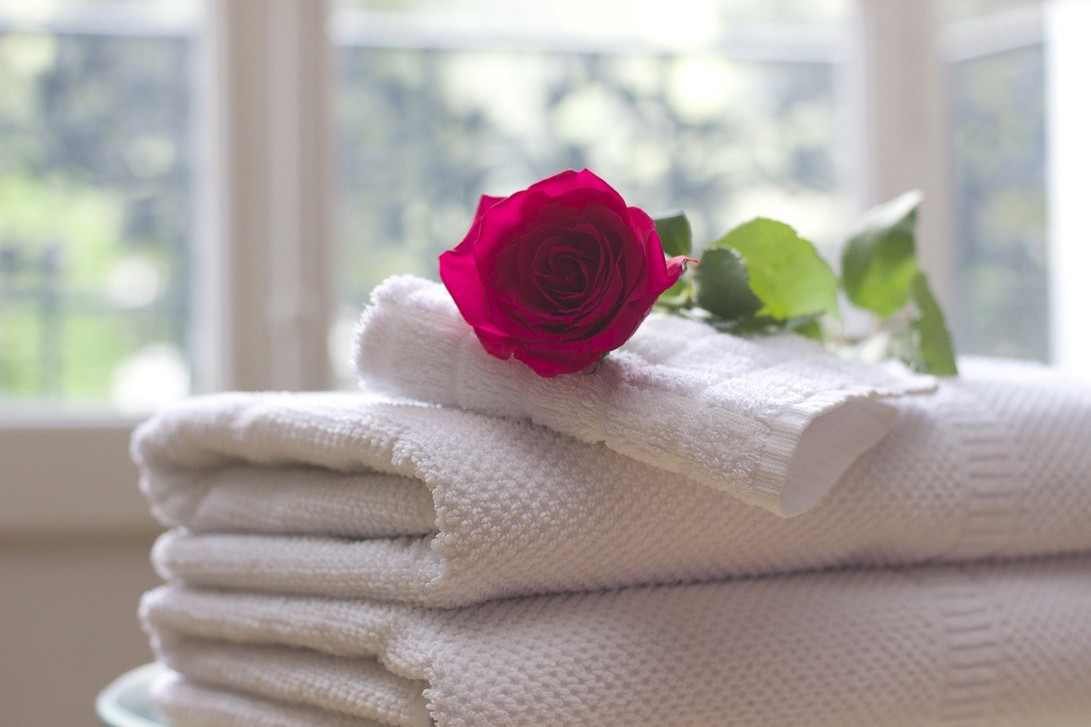Put yourself in their shoes: the road warrior stumbling bleary-eyed off a transcontinental red-eye; the blissful newlyweds giddy for their well-deserved luxury honeymoon; the family of five enjoying their first vacation after a busy school year. When a guest keys into their new hotel room, few things can make them feel more relaxed and refreshed than a hot shower and a fluffy, luxurious towel.

Hotels4Humanity knows that a lush stack of pristine towels will be one of the first things your guests lay their eyes on, and we’ve taken the time to pinpoint exactly how to deliver this luxury time and again through precise care.
To find fresh towels, visit Hotels4Humanity.
When to Wash:
It may be tempting to use a new towel right away when it’s at its fluffiest; however, the reason the towel looks so appealing fresh-off-the-shelf is because it’s treated with a chemical to maintain its display appearance. Washing once to remove this chemical is essential to avoid skin irritation and maximize absorbency.
It’s also essential to wash your terry regularly*, thereafter. Towels don’t discriminate in what they absorb: in addition to water, your towels soak up soap residue, skin cells, and anything else they may come into contact with, so washing after every few uses will prevent your towels from holding onto undesirable substances.
*If you’re worried about how your towel will hold up through multiple washes, the 1888 Mills Enduraweave and the WestPointIntelliweave are designed to withstand frequent washing.
Almost more important than washing often is washing correctly. The below tips and tricks will keep your towels as fresh and luxurious as when you bought them.
How to Wash:
Setting up for Success
Is your washing machine in good shape and ready to take on a load of dense, heavy towels? Make sure the machine is up to the job!
Cycle settings are critical to properly maintaining towels’ cleanliness and durability, but they will vary based on the condition of the load. Unfortunately, it isn’t as easy as “set it and forget it” - you have to properly assess each time what is needed from your washing cycle. Towels should always be washed in warm water in order to simultaneously eliminate bacteria while protecting the fibers.
Just as two’s company and three’s a crowd, you never want to overfill your washing machine. Overfilled machines don’t disperse the detergent evenly and prevent the mechanisms from properly agitating the load. However, an underfilled machine can also damage towels by over-agitating them and causing fibers to break down faster than they would as part of an average size load. Try to aim for a capacity of around 80% to help maximize the life of your towels.
Keep Good Company
Your towels should be washed separately from clothes and other textiles. Most terry needs to be laundered in a long, warm cycle since it produces a lot of lint. These cycles aren’t necessarily the best choice for your other fabrics.
Also, it should go without saying, but washing in like colors is the best way to prevent color loss and damage. Just because your towels are high quality, doesn’t mean they don’t need to be treated right!
You can find long-lasting colored towels that use 1888 Mills patented FiberTone and WestPoint’s Staybright technology towels by visiting Hotels4Humanity.
Determining Detergent
Achieving the appropriate pH while washing is essential to the maintenance of your towels’ soft and fluffy texture. Savvy hoteliers choose regular detergent -- the kind used in many homes -- over commercial-grade detergent, as the heavy-duty stuff strips away the soft fibers and degrade the towel faster than a more neutral soap.
Also, in the US, detergents are highly concentrated; often, the recommended amount is double what you need. Try washing a load with half the dose to avoid soap buildup and protect color.
Finally, you can consider washing colored towels in color-safe bleach and warm water (or white towels in regular bleach and warm water) to ensure maximum cleanliness.
Look No Further than Your Kitchen Cupboard
A simple and ubiquitous household product can work wonders for keeping your towels soft and vibrant. White vinegar protects the color of your towels while stripping away excess soap build-up from previous washes, improving absorbency and texture. Add one cup directly into the drum of your washer.
Another multi-use favorite is baking soda. Famous for its odor-fighting properties, baking soda can remove musty, damp smells that build up over time. It, too, aids in eliminating dirt and residual build-up, leaving your towels soft fluffy. Add about half a cup of baking soda in addition to the recommended amount of detergent.
Finishing Touches
Repeat after me: It’s time to ditch the fabric softener. In the short-term, they give fabrics a soft, conditioned feel, but over time they will create a waxy build-up and prevent your towel from absorbing -- which is kind of its main job!
A few simple tricks will keep your towels lint-free, absorbent, and fluffy after washing and drying. First, give your towels a quick shake before putting them in the dryer. Then, add a tennis ball (a new, clean one of course!) to the load to diffuse static and keep the towels tumbling, decreasing the time needed to dry.
Getting the timing right for your towels is essential to keeping their quality high. Leaving the towels damp can produce mildew, while over-drying will degrade the fibers over time. Monitor your drying cycle to best understand the amount of time needed.
Since you’ve spent all this time washing and drying your towels properly, make sure to store them neatly to ensure they stay fresh and clean. Try folding your towels into thirds to maximize space. You can also arrange towels on the shelf with the outer edges facing the front, making it easier to grab one towel at a time.
Now that we know how to care for towels, it’s time to understand how to choose a towel that best fits your needs.
How to Choose the Right Towel
Know your numbers
Towels have their own rating system based on the Gramps per Square Meter (GSM). The higher the GSM number, the thicker and denser the towel. Higher-rated GSM towels (400-600+) are not only softer and more luxurious, but also tend to last longer than lower GSM-count towels (200-300).
However, a high GSM rating isn’t always best for all guests, depending on what the towels will be used for. Towels with a lower GSM tend to be more lightweight, packable, and fast-drying after use. High-GSM also come at a higher cost. Understand a customer’s needs, expectations, and price point are critical in choosing the right towel for your hotel (or even different parts of your hotel).
Another metric to consider is Loops per Square Inch, which will help you determine how effectively it will dry and absorb. Longer fiber result in a higher Loops per Square Inch. Not only does a high loop count result in higher absorbency, the fiber loops also brush water away from the body, which plays a key role in drying quickly.
Feel Out Your Fabric Needs
Towels that are usually made for everyday use are usually a mid-grade basic cotton. Naturally, luxury towels use higher-end cotton. Luxury towels also have a longer fibers, resulting in a higher number of Loops per Square Inch.
Hotels towels made of Egyptian cotton are known for there heft and high GSM count which helps make them fluffy. American cotton, Pima, has also become popular, while lightweight bathrobes are mainly from Turkish cotton, which is usually less heavy than the Egyptian variety, while still delivering great absorbency.
To Color or Not to Color?
It’s hard to deny that plush, fluffy white towels give a clean, spa-like feel to any bathroom; hence, why they are so popular. White towels are also easy to maintain bright and pure by bleaching away stains. However, if you’re looking for a pop of color to stand out, Hotels4Humanity has everything you need.
The Choice Is Clear!
No matter what your hotel’s towel needs, you’ll be impressed with our collection of luxury towels at the best price. Come see for yourself by visiting Hotels4Humanity, we are at your service!

